Decanting experiments
- SushiNorth
- Martinez 1985
- Posts: 1341
- Joined: 06:45 Mon 18 Feb 2008
- Location: NJ & NY
Decanting experiments
[Split by jdaw1 from immediately after this post in Noval 1963 magnum TN.]
I was in a home-goods store with a coffeesaur (seur? like you can tell the difference between the two at 7!) and was discussing the filtering of Port sediment. I talked about the coffee filter and muslin experiments, and that I wished I could find a stainless steel screen of minutely fine grain.
Aside from the scientific grade ones she offered (which i feared might diminish from the port's body, take forever, and clog on the first pour), she pointed out a metal coffee filter. It happened to be a dome rather than a funnel shape, but have any of you tried the copper-colored metal coffee filters for removing port sediment?
I was in a home-goods store with a coffeesaur (seur? like you can tell the difference between the two at 7!) and was discussing the filtering of Port sediment. I talked about the coffee filter and muslin experiments, and that I wished I could find a stainless steel screen of minutely fine grain.
Aside from the scientific grade ones she offered (which i feared might diminish from the port's body, take forever, and clog on the first pour), she pointed out a metal coffee filter. It happened to be a dome rather than a funnel shape, but have any of you tried the copper-colored metal coffee filters for removing port sediment?
- Alex Bridgeman
- Croft 1945
- Posts: 16102
- Joined: 12:41 Mon 25 Jun 2007
- Location: Berkshire, UK
Please test and report back. We obsessives are interested.
Please test and report back. We obsessives are interested.
- SushiNorth
- Martinez 1985
- Posts: 1341
- Joined: 06:45 Mon 18 Feb 2008
- Location: NJ & NY
Both.
Both.
- SushiNorth
- Martinez 1985
- Posts: 1341
- Joined: 06:45 Mon 18 Feb 2008
- Location: NJ & NY
So i started in on this little experiment. I picked up a Cuisinart "4-Cup Gold Tone Filter: Permanent filter for the best coffee taste." It's basically a plastic frame with a exceptionally finely grained screen of a golden-copper color.
Tonight I tested it for taste on some Warre's Warrior I'd opened earlier in the week. I used the same funnel for both. The conclusion was that the taste (despite the heat) was the same, and that the gritty hint that comes in the filtered Warrior was only very slightly diminished. So I don't know if it will do a good enough job filtering a VP, that's to be determined, but it's flavor safe and suggests it'll do.
Next up: 1988 TFG.
Tonight I tested it for taste on some Warre's Warrior I'd opened earlier in the week. I used the same funnel for both. The conclusion was that the taste (despite the heat) was the same, and that the gritty hint that comes in the filtered Warrior was only very slightly diminished. So I don't know if it will do a good enough job filtering a VP, that's to be determined, but it's flavor safe and suggests it'll do.
Next up: 1988 TFG.
Decanting experiments
1. Thread split, as no longer commenting on that magnum of Noval 1963.
2. Please do continue to perform and report on decanting experiments. People are interested.
2. Please do continue to perform and report on decanting experiments. People are interested.
- Alex Bridgeman
- Croft 1945
- Posts: 16102
- Joined: 12:41 Mon 25 Jun 2007
- Location: Berkshire, UK
- SushiNorth
- Martinez 1985
- Posts: 1341
- Joined: 06:45 Mon 18 Feb 2008
- Location: NJ & NY
So this experiment is now underway, and I'll post pictures in a few minutes. As an ex-scientist, i worry about method and results.
Setup:
Half bottle of 1988 Taylor Fladgate Q-d-Vargellas VP emptied, including all sediment willing to go with the flow, into a liquid measuring cup. Volume: 1.5+ cups.
Method: Using a newly purchased and cleaned plastic funnel, a small amount of port will be decanted using each of the following filtering techniques. The port will be stirred in the measuring cup before each pour to ensure plenty of sediment is included, and the funnel will be wiped clean after each pour.
* No filter
* Coffee Filter, (Melitta, with flavor enhancing micro-perforations)
* Metal coffee filter (Cuisinart Gold-tone filter, see above)
* cheesecloth, folded 8-layers thick.
Sediment will be compared by examining port in a flat bottom glass over a white piece of paper, and by holding up to a strong halogen lightbulb.
Sediment sizes defined:
Tiny - no bigger than the tip of a pin, just visible.
Small - bigger than the tip of a pin, but not medium. Dust-like.
Medium - Small grains of sand
Large - chunky, flakes, etc.
Results:
There is a small amount of oily film on the top of the port in the measuring cup.
No filter (Control) : shows plenty of sediment of all sizes. Default taste for comparing others.
Coffee filter: showed no sediment of any size when poured, a small faint cloud of sediment gathered after 30 minutes. The texture in the mouth reflects no sediment. The oily film is not present. This is by far the slowest method, and required squishing it a bit to get the 2-3 tablespoons to filter. No unusual taste added.
Metal coffee filter: shows tiny sediment but plenty of it. Sediment is creating small cloudy areas in the glass. There is a hint of sediment on the tongue. The oily film is evident in the glass. Very fast. No unusual taste added.
Cheese Cloth: shows as much sediment as Metal filter, but even amounts of tiny and small sizes, with a couple grains of medium. There is a hint of sediment on the tongue, and something is causing the sediment to almost congeal in spirals. The oily film is only barely evident in the glass. Almost as fast as the metal filter. No unusual taste added.
Note: About that "oily residue on the surface" -- turns out it was simply a form of solid sediment that floated and clumped, making a thin crust on the surface.
Setup:
Half bottle of 1988 Taylor Fladgate Q-d-Vargellas VP emptied, including all sediment willing to go with the flow, into a liquid measuring cup. Volume: 1.5+ cups.
Method: Using a newly purchased and cleaned plastic funnel, a small amount of port will be decanted using each of the following filtering techniques. The port will be stirred in the measuring cup before each pour to ensure plenty of sediment is included, and the funnel will be wiped clean after each pour.
* No filter
* Coffee Filter, (Melitta, with flavor enhancing micro-perforations)
* Metal coffee filter (Cuisinart Gold-tone filter, see above)
* cheesecloth, folded 8-layers thick.
Sediment will be compared by examining port in a flat bottom glass over a white piece of paper, and by holding up to a strong halogen lightbulb.
Sediment sizes defined:
Tiny - no bigger than the tip of a pin, just visible.
Small - bigger than the tip of a pin, but not medium. Dust-like.
Medium - Small grains of sand
Large - chunky, flakes, etc.
Results:
There is a small amount of oily film on the top of the port in the measuring cup.
No filter (Control) : shows plenty of sediment of all sizes. Default taste for comparing others.
Coffee filter: showed no sediment of any size when poured, a small faint cloud of sediment gathered after 30 minutes. The texture in the mouth reflects no sediment. The oily film is not present. This is by far the slowest method, and required squishing it a bit to get the 2-3 tablespoons to filter. No unusual taste added.
Metal coffee filter: shows tiny sediment but plenty of it. Sediment is creating small cloudy areas in the glass. There is a hint of sediment on the tongue. The oily film is evident in the glass. Very fast. No unusual taste added.
Cheese Cloth: shows as much sediment as Metal filter, but even amounts of tiny and small sizes, with a couple grains of medium. There is a hint of sediment on the tongue, and something is causing the sediment to almost congeal in spirals. The oily film is only barely evident in the glass. Almost as fast as the metal filter. No unusual taste added.
Note: About that "oily residue on the surface" -- turns out it was simply a form of solid sediment that floated and clumped, making a thin crust on the surface.
Last edited by SushiNorth on 04:41 Sat 12 Apr 2008, edited 1 time in total.
- SushiNorth
- Martinez 1985
- Posts: 1341
- Joined: 06:45 Mon 18 Feb 2008
- Location: NJ & NY
Our filters for today:
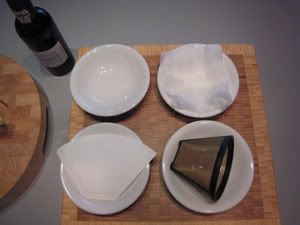
The cork, plenty dark.
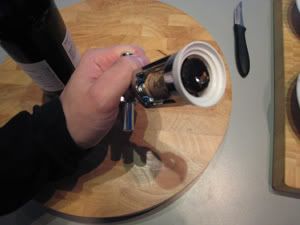
Half bottle is just over 1.5 cups:
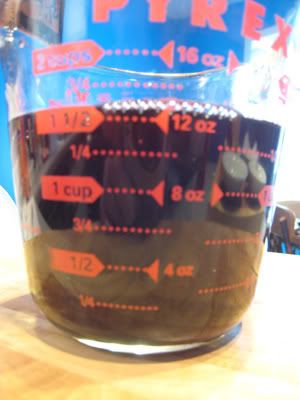
Color of the "no filter" port, tough to see the sediment in this photo:
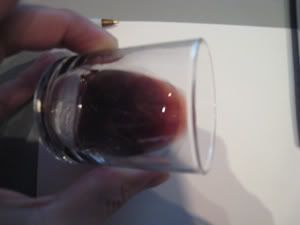
Coffee filter:
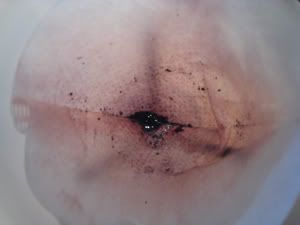
Color of the coffee filter sample -- looks the same as above, and still can't tell the difference on sediment. Last of this kind of photo.
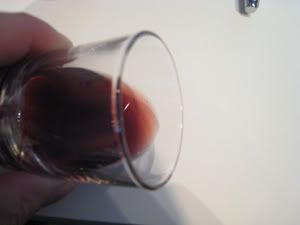
The metal filter, after the same amount of port was poured as the paper filter:
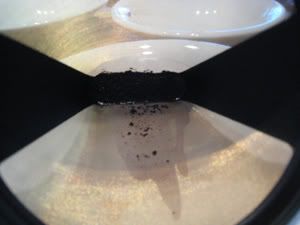
The 8-ply cheese cloth:
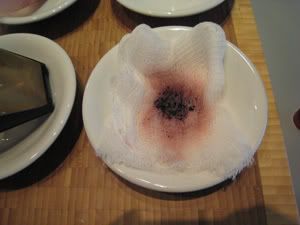
With only a little port left, it is easy to tell the difference in sediment size (TL no filter, BL paper coffee filter, TR Cheese cloth, BR Metal Filter) (Zoom):
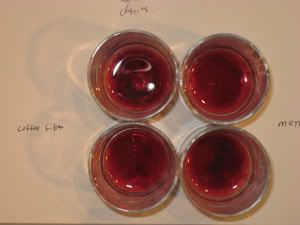
The dried sediment left in the bowl under the cheese cloth. This is the tiny and small sediment sizes, and it wipes more like grease than like grit.
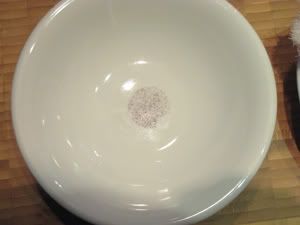
[/img]

The cork, plenty dark.

Half bottle is just over 1.5 cups:

Color of the "no filter" port, tough to see the sediment in this photo:

Coffee filter:

Color of the coffee filter sample -- looks the same as above, and still can't tell the difference on sediment. Last of this kind of photo.

The metal filter, after the same amount of port was poured as the paper filter:

The 8-ply cheese cloth:

With only a little port left, it is easy to tell the difference in sediment size (TL no filter, BL paper coffee filter, TR Cheese cloth, BR Metal Filter) (Zoom):

The dried sediment left in the bowl under the cheese cloth. This is the tiny and small sediment sizes, and it wipes more like grease than like grit.

[/img]
all non-slow things are approximately equivalent.
Thank you for the report, with pictures. It seems, again, that all non-slow things are approximately equivalent.
- SushiNorth
- Martinez 1985
- Posts: 1341
- Joined: 06:45 Mon 18 Feb 2008
- Location: NJ & NY
Re: all non-slow things are approximately equivalent.
Yes, basically if its slow it gives the particles time to adhere to the filter itself, but you'll note that even the coffee filter had a fine mist in it after I let it sit for a while (click the zoom and you can see it in the bottom-left glass). It was more evident in the right-hand glasses, with fast filtering.jdaw1 wrote:Thank you for the report, with pictures. It seems, again, that all non-slow things are approximately equivalent.
I didn't find any of this a detrimental effect on taste or on texture. A friend did warn me, though, that people who are sensitive to things like the bitterness in broccoli often say coffee filtered with a metal filter tastes metallic to them.
The biggest effect filtering had was on the time and effort it took to decant, and the appearance of the result. I brought the majority of that bottle (metal filtered) to a meeting tonight, and the three guys who tried it thought it was fine and didn't detect any grittiness.
- SushiNorth
- Martinez 1985
- Posts: 1341
- Joined: 06:45 Mon 18 Feb 2008
- Location: NJ & NY
Yeah, it's literally an attraction of the sediment particles to the filter. Metal doesn't have the same texture, microscopic fibers, as the paper and thus no vanderwaals or static effects. in addition, the liquid in the coffee filter doesnt go through the filter as much as it diffuses along the filter (which acts like a wick). So there's a lot more filtering going on. My gut reaction was that there would be too much filtering when i used the coffee filter, but i couldn't discern the difference.g-man wrote:that's awesome.
I wonder about cloudy port though. The cheese cloth/muslin does not render a cloudy port clear, but my hunch is that a coffee filter would.
- Alex Bridgeman
- Croft 1945
- Posts: 16102
- Joined: 12:41 Mon 25 Jun 2007
- Location: Berkshire, UK
Very interesting indeed. Thanks for posting such a good and detailed account of what you tried.
Another vote that filtering through unbleached coffee filter paper does not seem to affect the taste at all.
Alex
Another vote that filtering through unbleached coffee filter paper does not seem to affect the taste at all.
Alex
Top Ports in 2024: Niepoort 1900 Colheita, b.1971. A near perfect Port.
2025: Quevedo 1972 Colheita, b.2024. Just as good as Niepoort 1900!
2025: Quevedo 1972 Colheita, b.2024. Just as good as Niepoort 1900!